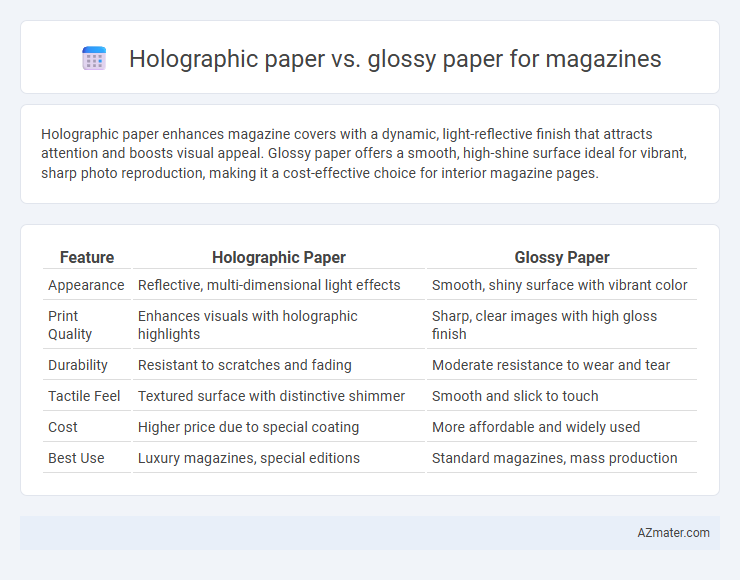Holographic paper enhances magazine covers with a dynamic, light-reflective finish that attracts attention and boosts visual appeal. Glossy paper offers a smooth, high-shine surface ideal for vibrant, sharp photo reproduction, making it a cost-effective choice for interior magazine pages.
Table of Comparison
| Feature | Holographic Paper | Glossy Paper |
|---|---|---|
| Appearance | Reflective, multi-dimensional light effects | Smooth, shiny surface with vibrant color |
| Print Quality | Enhances visuals with holographic highlights | Sharp, clear images with high gloss finish |
| Durability | Resistant to scratches and fading | Moderate resistance to wear and tear |
| Tactile Feel | Textured surface with distinctive shimmer | Smooth and slick to touch |
| Cost | Higher price due to special coating | More affordable and widely used |
| Best Use | Luxury magazines, special editions | Standard magazines, mass production |
Introduction: Holographic Paper vs Glossy Paper
Holographic paper uses a special film that reflects light to create a dynamic, rainbow-like effect, making magazine covers visually striking and attention-grabbing. Glossy paper, coated with a smooth, shiny finish, enhances image sharpness and color vibrancy, ensuring crisp, professional-quality prints. Choosing between holographic and glossy paper impacts the magazine's visual appeal and tactile experience, influencing reader engagement and brand perception.
Visual Appeal and Aesthetic Impact
Holographic paper offers a dynamic, eye-catching visual appeal with its iridescent sheen and light-reflecting properties, creating a futuristic and sophisticated aesthetic ideal for magazine covers and feature highlights. Glossy paper provides a sleek, polished finish that enhances color vibrancy and sharpness, delivering crisp, professional imagery that maintains consistent brightness under varied lighting. While holographic paper captivates with its unique texture and movement, glossy paper ensures clarity and vividness, making each choice pivotal depending on the magazine's desired visual impact and thematic tone.
Print Quality and Color Reproduction
Holographic paper enhances magazine print quality by adding a dynamic, reflective surface that amplifies color vibrancy and depth, creating a striking visual impact. Glossy paper offers high color saturation and sharp detail reproduction, ensuring vivid images and crisp text with a smooth, shiny finish. While holographic paper excels in attracting attention with unique light effects, glossy paper provides consistently accurate color reproduction for standard magazine content.
Durability and Lifespan
Holographic paper offers enhanced durability due to its multi-layered coating that resists scratches and fading, making it suitable for magazines requiring long-lasting visual impact. Glossy paper, while providing vibrant color and sharp imagery, tends to be more susceptible to fingerprints and surface wear over time. For magazine prints where lifespan and preservation are critical, holographic paper outperforms glossy paper in maintaining both appearance and structural integrity.
Cost Comparison
Holographic paper typically costs 20-30% more than glossy paper due to its advanced manufacturing process and unique reflective properties, making it a premium choice for magazine covers or special editions. Glossy paper remains the more economical option, with prices generally ranging from $0.10 to $0.30 per sheet, depending on weight and finish, ideal for bulk printing of standard magazine pages. The higher cost of holographic paper can be justified by its eye-catching appeal and marketing impact, but budget-conscious publishers often prefer glossy paper for cost efficiency and versatility.
Customization and Design Flexibility
Holographic paper offers exceptional customization with its dynamic light-reflective surface, creating eye-catching designs that enhance brand visibility in magazines. Glossy paper provides a smooth, high-shine finish that highlights vibrant colors and sharp images, allowing for detailed photo reproduction with consistent quality. Designers seeking innovative effects often prefer holographic paper for unique visual impact, while glossy paper remains a versatile choice for classic, polished presentations.
Reader Engagement and Perception
Holographic paper enhances reader engagement by creating a vibrant, eye-catching effect that makes magazine covers and special features stand out, increasing perceived value and curiosity. Glossy paper provides a smooth, reflective surface that delivers crisp images and vivid colors, promoting readability and a professional appearance. Choosing between holographic and glossy finishes depends on the magazine's target audience and content type, as holographic paper attracts attention through visual novelty while glossy paper ensures clarity and sustained reader focus.
Environmental Considerations
Holographic paper often contains metallic or plastic coatings that complicate recycling and increase environmental impact compared to glossy paper, which is generally easier to recycle due to its simpler coating composition. Glossy paper typically uses a clay or polyethylene coating that, while not entirely eco-friendly, supports better recycling processes and lower carbon footprints. Selecting glossy paper over holographic options helps magazines reduce landfill waste and supports more sustainable production cycles.
Suitable Applications for Magazines
Holographic paper enhances magazine covers and special editions with eye-catching, reflective patterns ideal for limited editions or promotional content, capturing reader attention through vibrant visual effects. Glossy paper suits high-quality image reproduction and text clarity, making it perfect for fashion magazines, lifestyle publications, and advertisements where sharp detail and vivid colors are essential. Selecting holographic paper prioritizes visual impact and novelty, while glossy paper focuses on professional presentation and readability for mainstream magazine content.
Choosing the Right Paper for Your Publication
Holographic paper offers a striking visual impact with its reflective, rainbow-like effects, making it ideal for eye-catching magazine covers or special editions that aim to stand out on newsstands. Glossy paper provides a smooth, shiny finish that enhances photo quality and text sharpness, ensuring vibrant images and professional presentation throughout the magazine's interior pages. Selecting the right paper depends on the desired aesthetic impact and budget, with holographic paper best suited for premium, limited runs, while glossy paper balances quality and cost for standard issues.

Infographic: Holographic paper vs Glossy paper for Magazine
 azmater.com
azmater.com